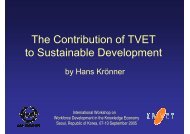Learning for Life, Work and the Future Initial ... - Unesco-Unevoc
Learning for Life, Work and the Future Initial ... - Unesco-Unevoc
Learning for Life, Work and the Future Initial ... - Unesco-Unevoc
You also want an ePaper? Increase the reach of your titles
YUMPU automatically turns print PDFs into web optimized ePapers that Google loves.
<strong>Learning</strong> <strong>for</strong> <strong>Life</strong>, <strong>Work</strong> <strong>and</strong> <strong>the</strong> <strong>Future</strong> Participants’ Papers Page 81<br />
with <strong>the</strong> CBET concept in order to qualify more <strong>and</strong><br />
different target groups <strong>for</strong> self-employment.<br />
INTEP:<br />
• Focuses on operators as a target group <strong>for</strong> potential<br />
growth <strong>and</strong> improved productivity<br />
• Analyses labour, goods <strong>and</strong> service markets against<br />
<strong>the</strong> competence levels of <strong>the</strong> target to ensure that<br />
<strong>the</strong> desired objectives of goods <strong>and</strong> services<br />
provision are met<br />
• Ensures a comprehensive approach with an environment<br />
conducive to <strong>the</strong> achievement of its goals; i.e.<br />
that technical skills should be a part of Business<br />
Development Services (BDS).<br />
6. <strong>Future</strong> Prospects<br />
On <strong>the</strong> basis of <strong>the</strong> positive results so far, VETA<br />
intends to consolidate <strong>the</strong> INTEP concept <strong>and</strong> exp<strong>and</strong><br />
its programmes. Some of its aims will be to:<br />
• Introduce <strong>the</strong> method in all VETA regions, train<br />
VETA staff, <strong>and</strong> involve more training institutions<br />
• Exp<strong>and</strong> <strong>the</strong> training activities, emphasising regional<br />
or local dem<strong>and</strong>s <strong>and</strong> options<br />
• Assess <strong>the</strong> impact of o<strong>the</strong>r training initiatives by<br />
self-help organisations, community development<br />
projects <strong>and</strong> small enterprise associations, <strong>and</strong><br />
create linkages with <strong>the</strong>m<br />
• Focus on economic growth areas with employment<br />
opportunities <strong>for</strong> <strong>the</strong> disadvantaged, such as small<br />
scale mining, agro-product processing, horticulture<br />
<strong>and</strong> export, educational training of child labour.<br />
To enhance its impact, VETA intends to exchange<br />
experiences with, <strong>and</strong> learn from, o<strong>the</strong>r countries of <strong>the</strong><br />
EAC <strong>and</strong> SADC regions whose programmes have<br />
achieved success in <strong>the</strong>se areas, such as ISTARN in<br />
Zimbabwe, STEP in Zambia, etc.<br />
Finances <strong>for</strong> training are generally scarce, <strong>and</strong> as contributions<br />
from <strong>the</strong> disadvantaged target groups will<br />
always be limited, <strong>the</strong> training programmes will have<br />
to be subsidised as a social responsibility. VETA will<br />
<strong>the</strong>re<strong>for</strong>e prepare proposals <strong>and</strong> invite bilateral <strong>and</strong><br />
international donors to contribute to INTEP programmes<br />
in order to contribute to employment promotion<br />
of <strong>the</strong> poorer people in Tanzania.<br />
25 RAZA, Stephen T. (Zimbabwe): Unemployment<br />
1. Executive Summary<br />
For a quarter of a century, <strong>the</strong> employment situation in<br />
Zimbabwe has attracted <strong>the</strong> attention of policy-makers<br />
<strong>and</strong> economists. An annual population growth rate<br />
cited at 3.6% by <strong>the</strong> 1969 census combined with<br />
sluggish employment growth gave rise to widespread<br />
concern in <strong>the</strong> 1970s that <strong>the</strong> country faced an alarming<br />
unemployment crisis. After independence in <strong>the</strong><br />
1980s, people thought things would change <strong>for</strong> <strong>the</strong><br />
better.<br />
Politicians were elated because <strong>the</strong>y had managed to<br />
acquire <strong>and</strong> sustain political independence. Educators<br />
sought Education <strong>for</strong> All, turning out unemployable<br />
“O” <strong>and</strong> “A” level graduates who eventually joined <strong>the</strong><br />
<strong>for</strong>mer guerrillas, <strong>the</strong> retrenched, <strong>and</strong> <strong>the</strong> uneducated<br />
unemployed who were already on <strong>the</strong> streets. Meanwhile,<br />
<strong>the</strong> businesses of white industrialists stagnated<br />
due to <strong>the</strong> uncertainty brought about by majority rule.<br />
Due to management inexperience, no industrial development<br />
programmes were designed to accommodate<br />
<strong>the</strong> changing political <strong>and</strong> educational needs.<br />
This paper looks at <strong>and</strong> seeks to discuss <strong>the</strong> trials <strong>and</strong><br />
tribulations that Zimbabwe went through in trying to<br />
address <strong>the</strong> unemployment situation; it examines <strong>the</strong><br />
current situation <strong>and</strong> makes proposals <strong>for</strong> ways in<br />
which Zimbabwe <strong>and</strong> SADC can address <strong>the</strong> problem.<br />
2. Background In<strong>for</strong>mation: Analysis of <strong>the</strong> Past<br />
<strong>and</strong> Present Unemployment Situation in<br />
Zimbabwe<br />
Although reliable unemployment figures were not<br />
readily available, at <strong>the</strong> end of 1984 <strong>the</strong> Ministry of<br />
Labour, Manpower Planning <strong>and</strong> Social Welfare<br />
estimated unemployment at 357,000, or 12.5% of <strong>the</strong><br />
labour <strong>for</strong>ce. However, if poverty was used as a yardstick,<br />
unemployment was probably underestimated as<br />
figures excluded <strong>the</strong> 1.4 million communal farmers.<br />
There was also a substantial amount of underemployment<br />
in <strong>the</strong> non-<strong>for</strong>mal employment sector.<br />
The Sou<strong>the</strong>rn African Political <strong>and</strong> Economic Monthly,<br />
SAPEM (June 2000), estimates <strong>the</strong> present population<br />
of Zimbabwe at 12.5 million. Unemployment is<br />
pegged at 45% in SAPEM, an increase of 32.5% from<br />
<strong>the</strong> 1984 underestimate of 12.5%.<br />
These figures do not take into consideration school<br />
drop-outs <strong>and</strong> school-leavers. The figures of retrenchees<br />
between <strong>the</strong> years 1999 <strong>and</strong> 2000 could be even<br />
more alarming if <strong>the</strong> following factors are taken into<br />
account:<br />
• Most companies folded in <strong>the</strong> year 2000 due to<br />
harsh economic times, uncertainty created by pre<strong>and</strong><br />
post-election violence <strong>and</strong>/or <strong>the</strong> l<strong>and</strong> redistribution<br />
issue.





